by Tom Gaylord, a.k.a. B.B. Pelletier
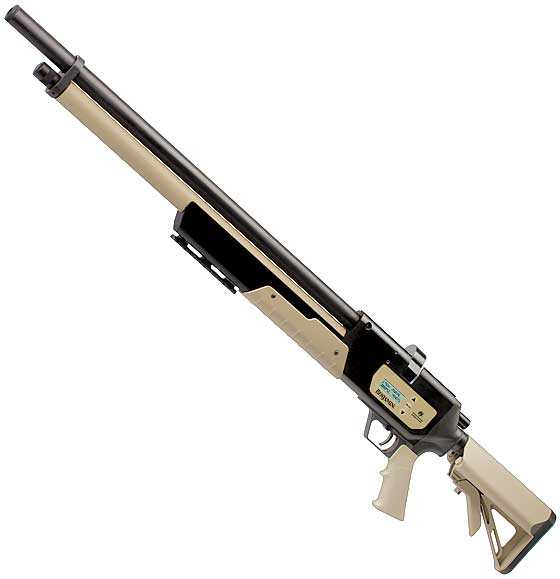
The new Rogue is simpler, more tractable.
Thank you for being so patient with me on this report! I was testing the Benjamin Rogue .357-caliber big bore rifle all month long, but I had nothing to report until now.
I go to the rifle range almost every week these days. I often have at least one airgun to test, and I also find that shooting firearms keeps my mind fresh so I can address airgun questions better. Plus, I just like to shoot and since this is my job — why not?
The first time I took the Rogue to the range I was trying three different styles of cast lead bullets that had been supplied to me when I reviewed it for you earlier. Crosman had sent two of them, and Mac gave me the third when he heard what I was testing. I never lubricate lead bullets that I shoot in big bore air rifles, so I took all three of these bullets to the range as they were cast. You need to know that, when a bullet is cast, it comes from the mold not perfectly cylindrical. In black powder arms, where I also shoot lead bullets as-cast but lubricated, the bore will make them round; and in so doing, they seal the bore better. The guns I shoot are all vintage arms with bores much larger than today’s guns of the same caliber — so it’s become a habit of mine to shoot bullets as-cast.
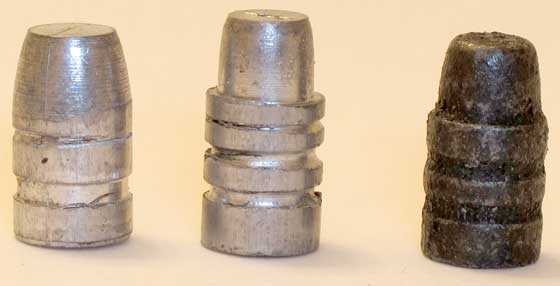
I first tried these three cast bullets in the Rogue. On the left is a 150-grain flat-point. The middle is a 156-grain semi-wadcutter. The dark bullet on the right is Remington’s 158-grain swaged bullet that’s been tumble-lubed in graphite. None of these worked well in the Rogue.
But I couldn’t get any of these bullets to feed into the Rogue at the range! They were all too big. So, that day was a bust. I did shoot a few Nosler Ballistic Tips, but we already know how accurate they are, so I didn’t bother reporting on that trip to the range.
When I returned home, I called Crosman and spoke to Ed Schultz — their head engineer. I told him that I thought they needed to cut a leade (a tapered entrance) into the breech so these larger bullets would fit. Ed told me that, in fact, they had cut a leade in the rifling — and they’re cutting what amounts to a bullet-sized chamber in the breech. The bullets I was feeding the rifle must have been larger than 0.359 inches in diameter. Well, of course they are, because cast lead bullets are never perfectly cylindrical until you size them. I hadn’t sized these bullets, so of course they were causing feeding problems. Problem solved!
The next time I went to the range, I took the same three bullets, and all were sized to 0.359 inches. That made all the difference! Now, they fed perfectly through the magazine and into the breech. But none of them were accurate. The best I was able to do was one 5-shot group of about 7 inches. But the average group was closer to 12 inches. And that’s at 50 yards off a rest. There was still nothing good to report.
I returned home and called Ed Schultz, again, to ask if the Rogue could handle any bullet other than the Nosler. The first time I tested the gun, I had success with a light bullet of less than 100 grains, but I was out of those and didn’t know where to get more. I hoped Ed would have an answer, and he did. He said they’d been having success with their Benjamin Pursuit 158-grain round-nosed bullet and their Benjamin Pursuit 127-grain flat-nosed bullet, and he said he would send me samples of each to test.
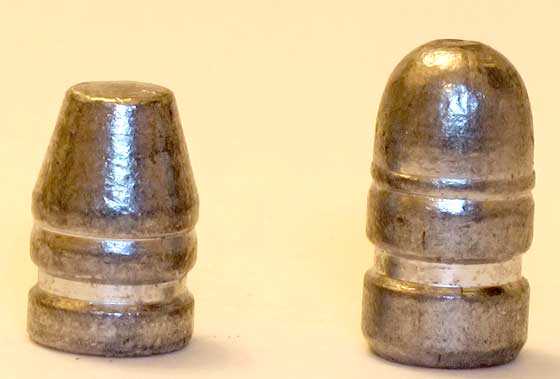
Two Benjamin Pursuit lead bullets for the Rogue. On the left is the 127-grain flat point, and on the right is the 158-grain round-nose.
Last week I went to the range with both new bullets and tested the Rogue with each. The results were very encouraging, and that’s what we’ll look at today! Let’s look at the 158-grain bullet first. This is a blunt-nosed lead bullet that mimics the old .38 Special 200-grain police revolver round, but is shorter. It comes unlubricated in a box of 50 and is a cast bullet with a beveled base for easier reloading. So somewhere there is a mold for this, or one can be made, if you cast your own as I do.
The bullet fed without a fault through the magazine, and I was surprised that it shot to the same general point of aim as the Nosler. Only a few clicks of elevation were required to get it printing where I wanted it. I selected the heavy bullet weight and the medium power level on the gun’s control panel to conserve air more than anything. The readout said that with 3,000 psi I had 7 good shots in the gun; but when I fired, that number dropped to 4…and then to 2. Instead of 7 shots, I got just 3 — but at least I knew exactly where the reservoir was at all times.
I decided to shoot 10-shot groups this time, so I shot 3 and refilled, and so on. For the final 4 shots, I shot past the low-air warning because I’d been told by Crosman that the gun was now keeping even the first couple of those shots within 30 f.p.s. of the average. The new software doesn’t allow as much variety of choices for bullet weight and power, but it controls the shot-to-shot consistency much closer. You give up some shots per fill, but you gain accuracy, as you will see.
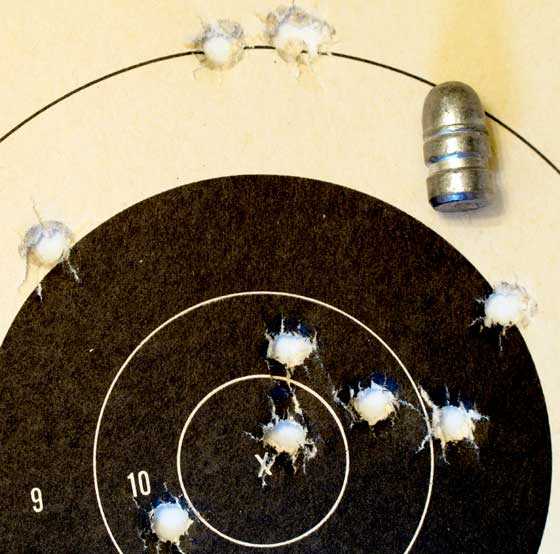
Ten 158-grain Benjamin Pursuit round-nosed bullets made this 2.587-inch group at 50 yards. That’s minute of coyote out at 80 yards.
Next, I tried the 127-grain flat-nosed bullet. For this one, I set the control at light for the bullet weight and medium for the power. The panel told me there were 11 shots at 3,000 psi, and I actually got 9. This time, the bullets all seemed to got to the same place on the target. What a wonderful little bullet this is for the Rogue!
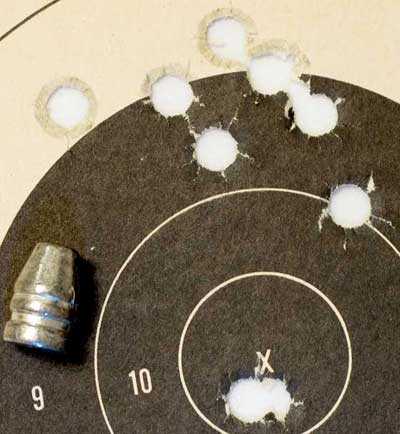
Ten 127-grain Benjamin Pursuit flat-pointsd went into this 1.835-inch group. This is the bullet for this rifle! There are four bullets in what looks like a string of three at the top right of the group and two in the X-ring.
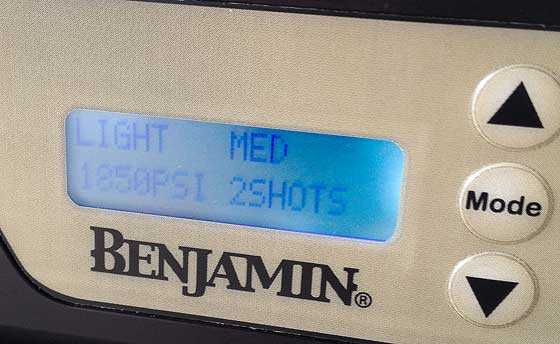
The readout on the last two shots with the 127-grain bullet. Notice the air pressure remaining. The readout disagreed with the gauge on my tank by 300 psi, but it was very accurate for controlling the gun.
I noticed while shooting the lighter bullet that the gun readout didn’t agree with the gauge on my air tank. It was off by 300 psi, yet it worked perfectly for the gun. So, I just paid attention to the gun readout, but filled using the gauge on my tank.
The trigger
I’d forgotten just how nice the new trigger is, but I have to say — Crosman got it right. It’s light, crisp and releases with no undue movement to the rifle. It feels like a mechanical trigger though I know it’s electronic. I do hope Crosman will put this trigger on other air rifles in the future, as I know you would all enjoy it.
Where we are
This test turned out to be a very pleasant surprise for me. After those times at the range when nothing went right, it was a surprise to learn that the new Rogue is a better shooter than it was in the first iteration. True, it doesn’t get as many shots per fill, but those shots it does get are all so stable that I don’t see how you could complain.
I still need to chrongraph the rifle with the two new bullets, plus I would like to see how it performs at high power. The reason I didn’t do that on this trip is because I know there isn’t that great a velocity difference between the two settings. But I still want to test it. So, we’re not done with the Rogue just yet.

G’day BB
Would the rifling twist affect the heavier pellets?
Cheers Bob
Bob,
That is probably the main factor, though did you notice how short and compact the Benjamin 158-grain bullet is, compared to the Remington bullet? So the shape of the bullet has a lot to do with it, as well. But yes, it does come down to the twist.
B.B.
All right, time to boast.
Weekend was spent on plywood. It made an impressive “cake” 62 mm thick and left it to polymerize, I hope 5 days will be OK for it to gain full strength. Then I will sand, drill and cut it to give it form I need, I guess 40% of its current volume will go into dust.
My receiver and bypass arrived only today, pics to follow, but I hope it’ll be Soviet space gothic enough for Matt 🙂 I’ll try to mount it onto “engine” assembly for the first time this evening and see what will happen.
duskwight
duskwight,
Man, to be so close after all these years! You must be elated!
B.B.
It’ll be great, duskwight! And no one else will have one!! 🙂
/Dave
You are the MAN Duskwight……..my fingers & toes are crossed! I can only imagine the elation when you finally shoot it!! Thanks for taking us along on the journey….really!
Dave,
I’d add – “for now”. I hope that in a year there will be some more men armed with DWR Mk.0 Mod.1 and I will be the happy owner of Mk.0 Mod.0 and Mk.1.
Yes, Soviet space gothic is great. The looks of the IZH 61 continue to grow on me. In other news, I just ordered the Huber Concepts anti-friction ball trigger for my Mosin. I’m actually getting into the interior of a gun! If Duskwight can pull off his gun, I will take this is as proof that I will be able to complete this drop-in trigger job. I’m also picking up the book on crossbow triggers that B.B. has recommended so that I can finally learn what a trigger sear is.
This is also related to our conversation about buying and selling. The fact is that I can’t be entirely sure about the provenance of my rifle. The claim is that it is a rifle rearsenaled by the Soviets after the war as a sniper rifle. So, I’m hoping that the parts went through the Great Patriotic War and the final product met the high Soviet standards for sniper rifles. It is not a rifle that went through the war as a sniper rifle which is okay. But I can’t know for sure if it isn’t some infantry rifle made to look like a sniper rifle afterwards. Anyway, I am hedging my bets by making it into a sniper rifle. Between my drop-in trigger job and careful handloading based on getting the bore slugged and the chamber depth measured, I will have a Soviet sniper rifle in my own universe!
Matt61
So, meet the receiver: http://i49.tinypic.com/34qqzgm.jpg
It fits perfectly to the engine.
I know that there must be some Soviet space gothic soundtrack, but I cannot stop myself from part murmuring, part whistling this tune – https://www.youtube.com/watch?v=hq2KgzKETBw 🙂
All right, some Soviet space for Matt61: https://www.youtube.com/watch?v=Sja4y5HzYu0
It’s a beautiful thing! Very professional looking and worth the wait I’m sure!
Hi BB
This may sound like a stupid question, but what is it that makes an airgun accurate? I imagine that many components contribute, including the power plant, the various barrel components (breech, bore, rifling, and muzzle), trigger as well as other peripherals like the stock and the sights.
If we ignored the peripherals and trigger and assume the pellets to be consistent in weight and calibre, it leaves us with the power plant and barrel. I would think that, as far as the power plant is concerned, the most important factor would be to deliver power (air) at a consistent level to the breech. If this is true, why are PCP guns and CO2 guns more accurate than springers? The power level of these guns is influenced by the pressure in the reservoir (PCP) and the outside temperature (in CO2 guns). This is true even in high quality pressure regulated PCP guns. A good quality springer usually delivers quite consistent power, but even a very good springer struggles to keep up with ordinary PCP guns. Why is this?
Looking at the barrel, I would think that, especially in break barrel guns, it is very important to have the barrel fixed very rigidly to the rest of the gun so that there cannot be any barrel movement when the barrel is closed and locked. There must also be accurate alignment between the transfer port and the barrel. These factors are probably not important in fixed barrel airguns with side lever or under lever cocking mechanisms. This would again suggest that fixed barrel springers with good, consistent power plants should at least be as accurate, if not more accurate, as PCP guns. Again, they are not. Why not?
The barrel is a complete mystery to me. I have no idea if and why the breech and the muzzle/crown should have any significant effect on accuracy, so I’m not even going to speculate about it.
The bore and the rifling seem to have intuitive importance, but I cannot really understand why. I imagine that having a bore that is consistent in diameter (calibre) and of the correct calibre throughout the length of the barrel is important, but maybe not – where do choked barrels fit into this accuracy puzzle? The rifling must obviously also be consistent and impart a rate of spin to the pellet that is appropriate for the velocity and the weight of the pellet.
This leads me to the question whether muzzle velocity consistency can be used as a predictor for accuracy? If you shoot a string and the muzzle velocity has a small range (spread) and small standard deviation, it would seem as if the power plant is producing consistent power, the power is transferred to the pellet consistently and that the pellet is travelling through the barrel at a consistent rate. Would this not predict a consistent point of impact and therefore small groups and good accuracy?
If all of this is true (and I don’t know whether it is), why is it so difficult to make accurate airguns? Wouldn’t it be easy to copy the design of a barrel that is known to be accurate, fit a good consistent power plant and have accurate airguns that do not cost more than $1000?
I would also like to add something about springer muzzle velocity and the effect of altitude and temperature. BB, you have previously referred me to a blog you have posted on velocity and altitude and it seems as if medium to a high-powered springers lose approximately 7% of velocity when going from sea level to about 5000 feet. I have done an Internet search to find out whether similar data exists regarding temperature and velocity, but all the references were about CO2 guns. I then did a little experiment myself. I first shot a few shots with my Hatsan Model 95.177 calibre to “wake it up” and then took it outside and shot a string of five shots. The average for the string was 756 FPS using 8.18 gr. H&N Finale Match rifle pellets. Average energy was 10.38 ft-lb. I then left the rifle standing in the sun (it was a nice warm day) for about half an hour before repeating the test. The average muzzle velocity increased to 845 FPS with the energy increasing to 12.97 Ft-lb. This represents a 12% increase in muzzle velocity and a 25% increase in muzzle energy. (For you guys who do not think that Hatsan can make proper airguns; the spread was only 10 FPS with a standard deviation of 3.96. That is very consistent!)
Your comments will really be appreciated.
Regards.
Vasco Ferreira.
Pretoria, South Africa.
Vasco,
Your comment will spawn several blogs, as I am sure other readers have similar questions they haven’t asked. Right now I’m wondering how to organize all the material I will write, so it doesn’t overwhelm people.
What makes an airgun accurate sounds like something I did address years ago, called the components of accuracy.
One theme you repeated is why is a PCP more accurate than a springer. That may be one possible way to start the answer.
I need to think about this some more before I formulate a plan to answer you.
B.B.
Thank you BB, it will be appreciated. In the meantimne, can you satisft my curiosity about the temperature/velocity issue?
Regards.
Vasco
Vasco,
Sure, Temperature goes up, lubricants get thinner — things go faster. It works in reverse, too.
B.B.
G’day BB
Would Boyle’s Law come into this and make the hot air less dense on compression so it moves faster?
Cheers Bob
Bob,
It would, but do you think the air is really hotter? The gun just heated a little from being in the sun.
B.B.
G’day BB
Turbo charged cars here in summer can lose quite a bit of measurable power in slow traffic conditions with the air being less dense due to not enough cooling. Obviously lack of 02 in this case.
You are the rocket scientist BB and this may require your investigation if you think warranted.
Cheers Bob
Bob,
I’m not the one! We need Rocket Jane Hansen.
B.B.
Heh, heh. Now, here’s a challenging question that encompasses just about the entire field of airguns. B.B. we wait for you… 🙂
As applied to the Rogue, I’m still a little mystified about its shooting behavior. It seems like a highly sophisticated computer system was put in and some component to accuracy was left out. Granted the final results with one of the results was quite good. But a 12 inch group at 50 yards with another bullet? 24 MOA?
Matt61
How would one know if one bought the Rogue that he was getting the latest version?
that was written about earlier,so is there a new number or model’
for that sum of money I would want the latest version.
I am puzzled why there are no air compressors under $1..500.00 I would hope
to see one at an affordable price some day.
No New Jersey Mike,
All the older Rogues were flushed out of the system before the new model was launched. Unsold guns were returned to Crosman, to be replaced with this model.
Only by buying a used gun or a gun from a hobby dealer who hasn’t kept up with his business could you buy an older model now.
B.B.
B.B.,
I for one would like to see a good trigger on the MAV 77, whenever that gets released. Hopefully Crosman doesn’t consider the MAV 77 too low-end for a good trigger. For sure, I’d hate to see a poor trigger on the MAV 77.
Victor
Victor,
I think the MAV 77 is off the table. It appears that Crosman is withdrawing several models that were shown at SHOT, and we may never see them.
B.B.
B.B.,
That is a real shame! Oh, well! Guess the TX 200 is the only way to go then.
See, here’s where I”m going with this. My thoughts are that the TX 200 is that “If you can only own one air-rifle…” type of gun, with the MAV 77 is being the exception.
Maybe that’s a good blog question? “If you could own just one air-rifle, what would it be, and why?”.
Thanks!
Victor
Victor,
this is a very difficult and unfair question but, if I only could own one air rifle, for a spring piston rifle it would probably be the HW or Beeman R-9 equivalent. Accurate, reliable, quality, useful for Field Target or hunting. As an althernative, the RWS 48 or 52. PCP – the Marauder, hands down. Probably my most accurate air rifle however if cost a factor and only being able to use a manual pump and not a SCUBA tank, I would downgrade to the Discovery. Finally, a Bluestreak from Benjamin. I would not own a CO2 as I’m just not a big fan of them. Final decision to be made based on space, cost, use, environment.
Fred DPRoNJ
Fred,
Your answer is along the lines of what I told my buddy who is becoming very interested in airguns. My short list of springers would include the TX 200, HW 97, and the R-9. But because he really loved my CF-X under-lever, so I recommended the TX-200 or the MAV 77. But it looks like the MAV77 isn’t going to happen.
I also suggested the Marauder, since he loved that one too. And because he does scuba diving, he’s already got 3 tanks.
Victor
Whoa, what happened? So we will never see the rematch between the MAV 77 and the TX 200. I would guess that the Chinese quality control is behind this one.
Matt61
Matt,
I’m sure there are other forces at work here also.
Victor
B.B.,
Don’t want to change the subject but since the MAV77 was brought up, please tell me that the Turbo Aire Pump will still be coming out. After using an Airforce pump for 11 years and never having an issue, I recently injured my shoulder. So pumping has become a chore now. I thought for sure the Turbo Aire pump would be the answer to my dreams. I call Crosman every 3 months or so and they say it’s still coming eventually. Would you have any inside info on this?
Thanks
That makes two of us hanging by a thread for that pump (though my memory doesn’t remember the long title for it)
I’m ready to spend most of 1-week of unemployment payments on that pump…
Wulfraed,
Yes I agree and I’m not a guy who buys a new item when it first comes out. I like to wait a year or so for them to work the kinks out. But in this case I will make an exception and pre-order the second I see it listed at PA’s website. With Crosman’s excellent customer service I am confident any problems will be addressed swiftly. I think they are just trying to make sure it is problem free before they release it.
Joe,
The pump was different. Crosman bought the design and was developing it. I hope it’s still on track, as well.
B.B.
BB,
I’m a little confused – are the right pictures of targets posted on the blog?
They do not seem to match the descriptions. If I scale of what I see using the bullets in the pictures, it looks like the 127 grain bullet’s ten shot group was closer to 2.5″ and the 158 grain’s ten shot group was around 3.25″ or so.
Are these the right pictures? I would expect a ten shot 0.835 inch group of .359 bullets to pretty much be one large hole . . .
Alan,
The pictures are correct. The scale of each is different. I can only put photos that are 560 pixels wide in the blog, and the target of the larger bullet is bigger than that.
Don’t measure the screen.
B.B.
BB,
I’m not trying to measure the screen.
Since to my eye, the pictures don’t seem to match the group size in the description (and they normally do!), I simply scaled the group size relative to the bullet shown in the picture – and I know I’m not making an accurate measurement this way. But for the 127 grain target, I get roughly seven bullet diameters between the centers of the two farthest holes – and for a group size of 0.835″ and a bullet of 0.359″, that should be less than three bullet diameters.
I don’t mean any disrepect, but if the pictures are correct then I think the group size has to be larger than indicated in the text. . . .
Alan in MI
Alan,
You found a mistake. That group is 1.835-inches. I thought I corrected that yesterday.
Thanks,
B.B.
Well, this post is very timely. I was reading in the Lyman reloading manual about how the .357 magnum cartridge, designed largely to defeat armor plate and bullet proof vests of gangsters, was the “first high-performance pistol cartridge.” What do you suppose that means? The .45 ACP seems to be pretty high-performing in its way and so does the .45 LC for that matter. No doubt this has something to do with the higher velocity. I could look at the velocity and energy values. But I’m wondering if there really is a threshold here as opposed to a continuous steady increase in energy. And can this be phrased in terms of some practical result like maybe the first pistol cartridge adequate for deer-sized game at a hunting distance? As another example, I believe B.B. was able to hit a basketball sized rock with a .38 special at 80 yards some number of times, and that seems pretty high-performance to me.
As a nugget from the Navy Seal sniper book that I mentioned, the author mentions a sniper contest between representatives of all the military and law-enforcement services. The winners were who you would expect along with the security teams for nuclear power plants. Nice to know. And as for cellar? … The FBI and the Secret Service! I’ve heard conflicting reports about the FBI. Lee Haney in his book on Delta Force claimed that some of them were very good. But the Secret Service certainly has not been distinguishing itself lately. At this contest, all the competitors were required to warm-up with a cold bore shot on a pie plate at 200 yards. Anyone who missed was required to buy a case of beer, and the Secret Service were making this a daily habit.
Matt61
Glad to hear this new model of the Rogue is going to be shot over the chronograph. Not sure I’ve ever read another 3 part series on an airgun on this blog without some chronograph numbers being reported. 😉
kevin
OKAY, is everyone ready for this? Our favorite lubricant, molybdenum disulfide, is undergoing research as a 2 dimensional semiconductor. The lubricant can be reduced in thickness to 3 atoms (or molecules ?) essentially making it two dimensional – length and width only. MIT researchers say it can usher in a new generation of transparent, flexible electronics, from chemical sensors to infra-red detectors to night vision systems. The latter references come from a researcher at the Army Research Lab so that explains why military type equipment is referenced. And you thought this stuff was only good for lubing air rifle pistons.
Fred DPRoNJ
Fred,
If you have ever messed with Moly and know semiconductor clean room procedures, you know it will be a revolution indeed!
BB,
I saw the typo on the second target last night, but held my tongue because I am always such a crank — thanks for fixing it when Alan pointed it out! 4MOA @50yards is better, but I think I can beat it with my Glenfield 60 and open sights with bulk ammo, certainly off a bench, and it didn’t cost anywhere near what this rig does. Lighter bullets, as there is certainly a pattern. What is the rifling rate?
As it is, I can’t see any advantage over something more conventional — the use of bullets removes the safety advantage of diabolo pellets, right? I’m not the world’s biggest expert on salesmanship, but it seems like it is easier to sell what people need and want at a price competitive with other alternatives. What does this thing do that I can’t do some other way better? A decent short-throw lever action with .38/.357M chamber would dust it in terms of power and accuracy and still leave half the money in ones pocket. I bet ammo costs would be similar with careful shopping, also. A .40 cal. PRB rifle would be very competitive as well, and much cheaper, not to mention possibly safer. Sorry, just my opinion — feel free to explain how I’m wrong.
BG_Farmer,
You’re only wrong because this is an airgun blog. Sure there are firearms that can beat it. But they use gunpowder. This is just using air. By itself. Without anything else. Alone.
B.B.
BB,
I’m sorry about the firearms talk, as I can only speak about what I’m somewhat familiar with, and I tend to put everything I shoot into the same bin, no matter what the propellant. Going out on a limb, though, Dennis Priddy has supposedly shot competitive scores in NMLRA offhand matches with a (.40 cal.?) ball tank PRB rifle (talk about different approach) — and “competitive” is not an idle descriptor in those matches; he most likely has some bench data. Can this one shoot roundballs (I realize they could not be patched in the cylinder)?
BG_Farmer,
No need to apologize. I just wanted to remind everyone what we are talking about here.
Yes, the Rogue could shoot round balls, but the twist might be a little fast. No problem with that, I just mentioned it.
B.B.
BB,
My .50 caliber pistol has 1:20 twist and it shoots ~190gr. roundballs fine with 20gr (max. 800fps, if that), IFF I can hold it steady (birds beak grip with single hand explains low fatality rate in duels, according to my experience :)). What happened to the 95gr. hollowpoints from the first test? They seemed promising, and I would almost bet money that a 70 gr. (hollow base) would be even better. Worst case, some diabolo style projectiles could be cast! I really want to see Lloyd’s and your work succeed, even if I think this product isn’t perfect (through no fault of yours and his), and I don’t mean to seem so negative!
BG_Farmer,
Those 95-grain slugs are the ones I mentioned that I no longer have.
Crosman says that below about 115 grains the bullets aren’t too accurate, but I don’t have anything that light to try in it.
B.B.
Classic dueling pistols are smoothbore — contributing to the survivability, as they aren’t really accurate (they may be fancy, expensive, with the fanciest triggers around, but get to the bore and forget about hitting anything)
I forget whose dueling pistols it was that were x-rayed a few decades ago [the museum wouldn’t permit disassembly] — whereupon it was discovered that they had single set triggers; upon cocking they would behave as a regular heavy pull trigger, but one knowing the secret could press the trigger /forward/ to set it for a light pull.
I believe many if not most pistols were smooth bored until the 1850’s perhaps? I suppose that did contribute to their inaccuracy, but there is some evidence that they could be fired very accurately by some (e.g. Andrew Jackson and esp. his opponent Charles Dickinson). At pistol ranges, I suspect accuracy had to do with how much one practiced, as the handles (until the later saw handle came about) and shooting style makes it more difficult than modern pistols. It has long been my suspicion that in the “duel” between Jackson and John Sevier, each understood that the other could and would kill them, so neither shot at each other (I believe some say they shot into the air) after what was something like an hour of screaming at each other. Single sets were common, in my understanding. I believe it was the place of the “seconds” to load the pistols, cock the locks, and set the triggers (if a set trigger). Single set triggers aren’t uncommon, and they would be particularly good on a pistol where the length of the guard bow is limited. I think the English favored them on target rifles early on as well, although they did not like double set triggers that were common in US.
The Rogue might (in some enlightened states) be ranked with black powder muzzle loaders in hunting season… Depends, probably, on the velocity results.
And cleaning the Rogue is no doubt easier than a powder burner…
(I don’t want to consider MI — I still have trouble figuring what would be permissible where; I know I’m in the section of the state in which firearm deer season is shotgun-only; the rules for handguns seem perverted, and black powder may or may not be permitted in the “shotgun zone”)
I agree with you, I’m not sure I fully grasp the concept of big bore air rifle yet.
Don’t get me wrong! I would buy one if I could, I love what you can do with it, the fact that you can shoot big caliber bullets/ammo/pellets with air only but to me it’s kind of a novelty item.
I’ve already said how much I like the e-valve and the endless possibilities I see in it but I’m just not sure the Rogue is the best platform for it. A Marauder or even a disco (with it’s low psi fill level) with this e-valve sounds better to me. I’m not against it at all, on the contrary! BUT I don’t think it’s for me.
9 shots per fill isn’t fun for me (especially since I still have to pump it).
I just hope Crosman judges it’s worth it and make a small bore version.
J-F
I agree about the small-bore version — something like .25 caliber (probably more cast options, pellets might even work) or 6mm would be my preference. If it could shoot short range benchrest with suitable accuracy and with enough shots/fill, it might be a decent seller even in its current form (which is horrible for field use); it wouldn’t even need the repeating capability.
B.B.,
So what do you think is preventing the Rogue from shooting tighter groups?
Is it lacking the velocity necessary to stabilize such a heavy round?
Might there be a smaller caliber bullet that is better suited for a high-power air-rifle?
(In other words, maybe air-rifles are the wrong platform for big-bore?)
Victor
Victor,
I don’t think I have tested the Rogue enough to answer your question.
B.B.
I want to make a brief appearance to say how much I am enjoying these blogs on the Rogue. No matter what I actually purchase or use, I am always of the mind set of Tim Allen, “more is better”!!!
I saw the neurosurgeon a few days ago. I am going to have another MRI and a 62 or 64 slice CT-scan soon.
All in all, it’s good to be alive.
I used to shoot round balls (many moons ago) out of my .177 break barrell and my Sheridan Blue Streak. I’m sure they were more accurate than I was.
~Ken
Ken,
it’s certainly great to hear from you. Keep fighting the good fight. Hopefully, the time is pretty near when you can say to your doctor, “I hope I never see you again”. That’s what I said and he cracked up.
Fred DPRoNJ
Ken,
Good to hear from you! And ditto what Fred said. Docs enjoy hearing that.
B.B.
BB,
I have tried to support Crosman on the Rogue project. I believe the e-valve will be important someday. I think Crosman needs to deliver better accuracy and better shot count on the heavier pellets. The Rogue is not the equal of the Korean big bores in accuracy or power.
David Enoch